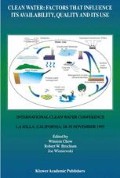Abstract
The almost universally accepted operational definition for dissolved constituents is based on processing whole-water samples through a 0.45-μm membrane filter. Results from field and laboratory experiments indicate that a number of factors associated with filtration, other than just pore size (e.g., diameter, manufacturer, volume of sample processed, amount of suspended sediment in the sample), can produce substantial variations in the ‘dissolved’ concentrations of such elements as Fe, Al, Cu, Zn, Pb, Co, and Mi. These variations result from the inclusion/exclusion of colloidally-associated trace elements. Thus, ‘dissolved’ concentrations quantitated by analyzing filtrates generated by processing whole-water through similar pore-sized membrane filters may not be equal/comparable. As such, simple filtration through a 0.45-μm membrane filter may no longer represent an acceptable operational definition for dissolved chemical constituents. This conclusion may have important implications for environmental studies and regulatory agencies.
Access this chapter
Tax calculation will be finalised at checkout
Purchases are for personal use only
Preview
Unable to display preview. Download preview PDF.
References
APHA-AWWA-WPCF: 1989, Standard Methods for the Examination of Water and Wastewater, 17th Ed., 1193p.
ASTM: 1995, Annual Book of ASTM Standards, Vol 11.01, Water (I), 814p.
Beckett, R.; Nicholson, G.; Hart, B.T.; et al: 1988, Water Research, 22, p. 1535–1545
Benoit, G.: 1994, Environmental Science & Technology, 22, 1987–1991
Brewer, P.G. and Spencer, D.W.: 1970, Trace Metal Intercalibration Study., Woods Hole Oceanographic Institute, Report No. 70–62.
Bruland K.: 1983, Trace Elements in Sea-Water, In Chemical Oceanography, 5, (Edited by Riley, J., Chester, R. ), 157–220.
Flegal A. and Coale K.: 1989, Water Resources Bulletin, 25, 1275.
Hoffman, M.R., Yost, E.C., Eisenreich, S.P., and Maier, W.P.: 1981, Environmental Science and Technology, 15, 655–661.
Horowitz, A .J., Demas, C.R., Fitzgerald, K.K., et al.,: 1994, U.S. Geological Survey Open-File Report No. 94-539, 56p.
Horowitz, A.J., Elrick, K.A., and Colberg, M.R., 1992, Water Research, 26, 753–763.
Jones, P.G.W.: 1978, International Council for the Exploration of the Seas. Copenhagen, ICES, CM 19787/E:16.
Karlsson, S., Peterson, A.;,Hakansson, K., and Ledin, A.: 1994, The Science of the Total Environment, 194, 215–223.
Laxen D. and Chandler, I.: 1982, Analytical Chemistry, 54, 1350–1355.
Ledin, A.: 1993, Colloidal Carrier Substances — Properties and Impact on Trace Metal Distribution in Natural Waters., Linkoping Studies in Arts and Science No. 91.
Martin, J.M.. and Meybeck, M.: 1979, Marine Chemistry, 7, 173 - 206.
Nriagu, J.O., Lawson, G., Wong, H.K.T., and Azcue, J.M.:1993, Journal of Great Lakes Research, 19, 175–182.
Office of Water Data Coordination: 1984, National Handbook of Recommended Methods for Water-Data Acquisition., Chapter 5,5-14–5-15.
Rees, T.F. and Ranville, J.F.: 1990, Journal of Contaminant Hydrology, 6, 241–250.
Shiller A. and Boyle E.:1987, Geochimica et Cosmochimica Acta, 51,3273–3277.
Taylor, H.R. and Shiller, A.M.:1995, Environmental Science and Technology, 29, 1313–1318.
U.S. Environmental Protection Agency: 1983, Methods for Chemical Analysis of Water and Wastes EPA-600/4- 79-020,375 p.
Wagemann, R. and Brunskill G.:1975, International Journal of Environmental Analytical Chemistry, 4, 75–84.
Windom, H., Byrd, H., Smith, Jr. H., and Huan, F.: 1991, Environmental Science & Technology, 25, 1137–1142.
Author information
Authors and Affiliations
Rights and permissions
Copyright information
© 1996 Kluwer Academic Publisher
About this chapter
Cite this chapter
Horowitz, A.J., Lum, K.R., Garbarino, J.R., Hall, G.E.M., Lemieux, C., Demas, C.R. (1996). The Effect of Membrane Filtration on Dissolved Trace Element Concentrations. In: Clean Water: Factors that Influence Its Availability, Quality and Its Use. Springer, Dordrecht. https://doi.org/10.1007/978-94-009-0299-2_27
Download citation
DOI: https://doi.org/10.1007/978-94-009-0299-2_27
Publisher Name: Springer, Dordrecht
Print ISBN: 978-94-010-6619-8
Online ISBN: 978-94-009-0299-2
eBook Packages: Springer Book Archive

